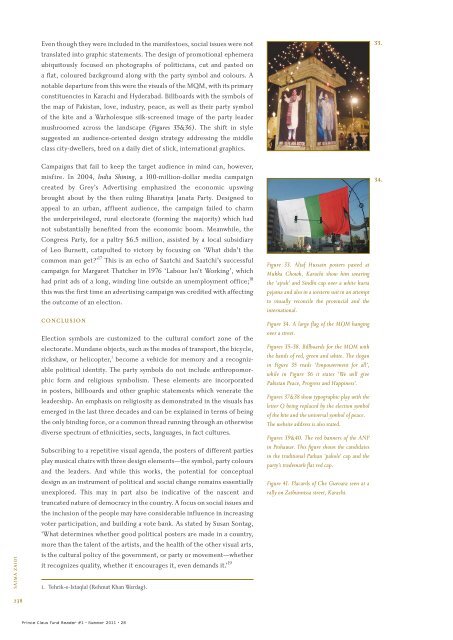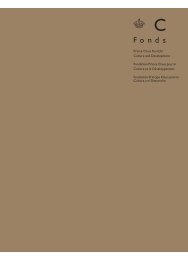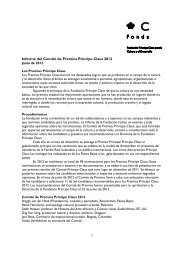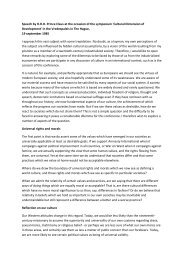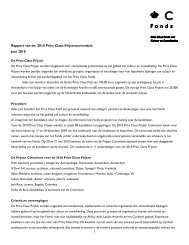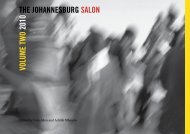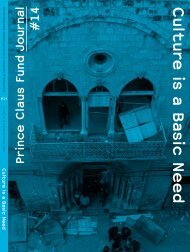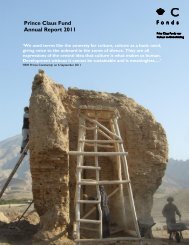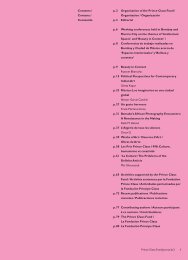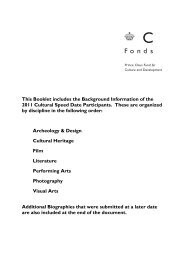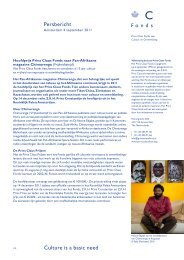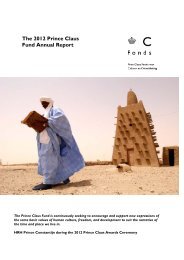3 summer 2011 - Prince Claus Fund
3 summer 2011 - Prince Claus Fund
3 summer 2011 - Prince Claus Fund
- No tags were found...
You also want an ePaper? Increase the reach of your titles
YUMPU automatically turns print PDFs into web optimized ePapers that Google loves.
Even though they were included in the manifestoes, social issues were nottranslated into graphic statements. The design of promotional ephemeraubiquitously focused on photographs of politicians, cut and pasted ona flat, coloured background along with the party symbol and colours. Anotable departure from this were the visuals of the MQM, with its primaryconstituencies in Karachi and Hyderabad. Billboards with the symbols ofthe map of Pakistan, love, industry, peace, as well as their party symbolof the kite and a Warholesque silk-screened image of the party leadermushroomed across the landscape (Figures 35&36). The shift in stylesuggested an audience-oriented design strategy addressing the middleclass city-dwellers, bred on a daily diet of slick, international graphics.33.saima zaidi238Campaigns that fail to keep the target audience in mind can, however,misfire. In 2004, India Shining, a 100-million-dollar media campaigncreated by Grey’s Advertising emphasized the economic upswingbrought about by the then ruling Bharatiya Janata Party. Designed toappeal to an urban, affluent audience, the campaign failed to charmthe underprivileged, rural electorate (forming the majority) which hadnot substantially benefited from the economic boom. Meanwhile, theCongress Party, for a paltry $6.5 million, assisted by a local subsidiaryof Leo Burnett, catapulted to victory by focusing on ‘What didn’t thecommon man get?’ 17 This is an echo of Saatchi and Saatchi’s successfulcampaign for Margaret Thatcher in 1976 ‘Labour Isn’t Working’, whichhad print ads of a long, winding line outside an unemployment office; 18this was the first time an advertising campaign was credited with affectingthe outcome of an election.conclusionElection symbols are customized to the cultural comfort zone of theelectorate. Mundane objects, such as the modes of transport, the bicycle,rickshaw, or helicopter, i become a vehicle for memory and a recognizablepolitical identity. The party symbols do not include anthropomorphicform and religious symbolism. These elements are incorporatedin posters, billboards and other graphic statements which venerate theleadership. An emphasis on religiosity as demonstrated in the visuals hasemerged in the last three decades and can be explained in terms of beingthe only binding force, or a common thread running through an otherwisediverse spectrum of ethnicities, sects, languages, in fact cultures.Subscribing to a repetitive visual agenda, the posters of different partiesplay musical chairs with three design elements—the symbol, party coloursand the leaders. And while this works, the potential for conceptualdesign as an instrument of political and social change remains essentiallyunexplored. This may in part also be indicative of the nascent andtruncated nature of democracy in the country. A focus on social issues andthe inclusion of the people may have considerable influence in increasingvoter participation, and building a vote bank. As stated by Susan Sontag,‘What determines whether good political posters are made in a country,more than the talent of the artists, and the health of the other visual arts,is the cultural policy of the government, or party or movement—whetherit recognizes quality, whether it encourages it, even demands it.’ 19i. Tehrik-e-Istaqlal (Rehmat Khan Wardag).Figure 33. Altaf Hussain posters pasted atMukka Chowk, Karachi show him wearingthe ‘ajrak’ and Sindhi cap over a white kurtapyjama and also in a western suit in an attemptto visually reconcile the provincial and theinternational.Figure 34. A large flag of the MQM hangingover a street.Figures 35–38. Billboards for the MQM withthe bands of red, green and white. The sloganin Figure 35 reads ‘Empowerment for all’,while in Figure 36 it states ‘We will givePakistan Peace, Progress and Happiness’.Figures 37&38 show typographic play with theletter Q being replaced by the election symbolof the kite and the universal symbol of peace.The website address is also stated.Figures 39&40. The red banners of the ANPin Peshawar. This figure shows the candidatesin the traditional Pathan ‘pakole’ cap and theparty’s trademark flat red cap.Figure 41. Placards of Che Guevara seen at arally on Zaibunnissa street, Karachi.34.<strong>Prince</strong> <strong>Claus</strong> <strong>Fund</strong> Reader #1 · Summer <strong>2011</strong> · 28


